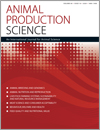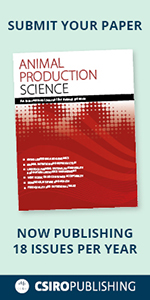
Animal Production Science
Volume 60 Number 16 2020
Variations in tenderness of beef continue to be an important concern for consumers and therefore an economic issue for the meat industry. This study shows that some single nucleotide polymorphisms (SNPs) in a specific candidate gene impact connective tissue strength in raw meat, and depending on cooking conditions, this may contribute to variations in cooked meat toughness in addition to the previously known effects of these polymorphisms on intramuscular fat content. If these SNPs do not adversely affect animal growth, they may be used in the selection of cattle to reduce the contribution of collagen to the toughness of cooked beef.
AN19593MicroRNA-141 participates in milk lipid metabolism by targeting SIRT1 in bovine mammary epithelial cells
The functions of miR-141 and the mechanisms by which it affects milk lipid metabolism in mammary gland development and lactation remain unclear. Our study revealed the mechanisms of miR-141 regulates lipid metabolism by regulating lipid metabolism-related genes and targeting SIRT1 in BMECs. This indicates that miR-141 could be considered a marker in cattle breeding to obtain high quality dairy products.
Mixed mycotoxin contaminations in feed impose the adverse effect on poultry production, particularly in hot and humid conditions. Herb such as Thunbergia laurifolia (TL), with supported medicinal properties, was examined for its effect on the zootechnical and physiological parameters in broilers receiving mycotoxin-contaminated feed. Supplementation with this herb showed the protective effect and it can be used as an alternative mycotoxin adsorbent in broiler production.
AN18638Effect of grapeseed procyanidins on small intestinal mucosa morphology and small intestinal development in weaned piglets
The effect of grapeseed procyanidins (GSP) on small intestinal mucosa morphology and small intestinal development was studied in weaned piglets. Dietary supplementation with GSP generated a beneficial role in small intestinal health by improving small intestinal mucosa morphology and promoting small intestinal development in weaned piglets. These results provide information on the use of GSP for relieving weaning stress in piglets.
Selenium is a dietary essential trace element and plays important roles in the body, including being a powerful antioxidant and an immune-system booster. Various sources of selenium have variable bioavailabilities and different tissue retentions in broilers. Selenium nanoparticles are efficiently absorbed by enterocytes and have high retention in breast muscle of broilers when compared with organic and inorganic forms of selenium.
AN18722Effect of yeast culture (Saccharomyces cerevisiae) and garlic (Allium sativum) product mixture on growth performance, nutrient digestibility, faecal microflora, faecal noxious-gas emission and meat quality in finishing pigs
The withdrawal of antibiotic growth promoters means that alternative growth promoters need to be identified. The present study investigated the combination of yeast culture, garlic extract and garlic essential oil as a feed additive on performance and production characteristics in finishing pig. The results of this study provide evidence and insight for the application of probiotic and phytogenic combined feed additive in pigs.
AN19281Effect of Flemingia macrophylla silage on in vitro fermentation characteristics and reduced methane production
 , Metha Wanapat, Pajaree Totakul, Burarat Phesatcha, Thiwakorn Ampapon and Anusorn Cherdthong
, Metha Wanapat, Pajaree Totakul, Burarat Phesatcha, Thiwakorn Ampapon and Anusorn Cherdthong 
Flemingia macrophylla silage (FMS) is nutritious feed which can enrich rumen fermentation efficiency. Strategic supplementation of FMS with crop-residue resulted in increases of propionate, in vitro dry matter degradability and reduction of acetate, protozoal population and methane production. FMS is a potential and promising feed for ruminants.
AN19687The influence of heat load on Merino sheep. 1. Growth, performance, behaviour and climate
Heat stress concerns can arise during live export voyages, particularly when voyages travel from the southern hemisphere winter to the northern hemisphere summer. This study highlighted that sheep were capable of maintaining feed intake and growth when exposed to heat load simulating live export conditions. However, sheep exposed to heat load showed a 137% increase in water intake. These results may indicate that the climatic conditions experienced by sheep during voyages may not be as critical as previously thought.
AN20268The influence of heat load on Merino sheep. 2. Body temperature, wool surface temperature and respiratory dynamics
During live export voyages, sheep can be exposed to relatively rapid changes in ambient conditions within a short period of time (≤29 days), raising heat load concerns. This study highlighted that the climatic conditions imposed were sufficient to disrupt the thermal equilibrium of these sheep, resulting in increased respiration rate, panting score and body temperature. Overall, these results suggest that the sheep were unable to completely compensate for the imposed heat load via increased evaporative heat loss through respiration, resulting in an increase in body temperature.
AN19689The influence of heat load on Merino sheep. 3. Cytokine and biochemistry profiles
 , G. Wijffels, R. McCulloch, S. Stockwell, H. Owen, M. L. Sullivan, J. C. W. Olm, A. J. Cawdell-Smith and J. B. Gaughan
, G. Wijffels, R. McCulloch, S. Stockwell, H. Owen, M. L. Sullivan, J. C. W. Olm, A. J. Cawdell-Smith and J. B. Gaughan
During live export voyages, sheep can be rapidly exposed to heat stress conditions. Animals are biologically programmed to minimise the impacts of heat stress via a range of physiological functions. The results presented here highlight that the metabolic and inflammatory status of sheep exposed to incremental heat load, simulating a live export voyage from a southern hemisphere winter to a northern hemisphere summer, are variable; however, they suggest that adaptive changes do occur.
Improving lamb survival has the potential to increase profit to the Australian sheep industry by AU$1 billion per year. Our national research demonstrated that reducing mob size at lambing will improve lamb survival. These findings will contribute to current guidelines for managing lambing ewes to improve lamb survival across Australia.
AN18792In vivo assessment of body composition and growth potential of modern broiler using dual-energy X-ray absorptiometry
 , Nilva Kazue Sakomura, Miryelle Freire Sarcinelli, Letícia Graziele Pacheco
, Nilva Kazue Sakomura, Miryelle Freire Sarcinelli, Letícia Graziele Pacheco  , Letícia Soares, Mirella Cunha Melaré, Warley Junior Alves and Robert Mervyn Gous
, Letícia Soares, Mirella Cunha Melaré, Warley Junior Alves and Robert Mervyn Gous
Studies evaluating the chemical composition in meat chickens are important for assessing the growth of protein and body mass fat, and they have mainly been carried out on carcasses. Dual-energy X-ray absorptiometry (DXA) is a scanning method that enables assessment of animals slaughter. The body composition and growth of different commercial broiler breeds were measured by DXA and through mathematical models that simulate growth, even though genetic companies do not disclose this information due to their long-term breeding programs.



